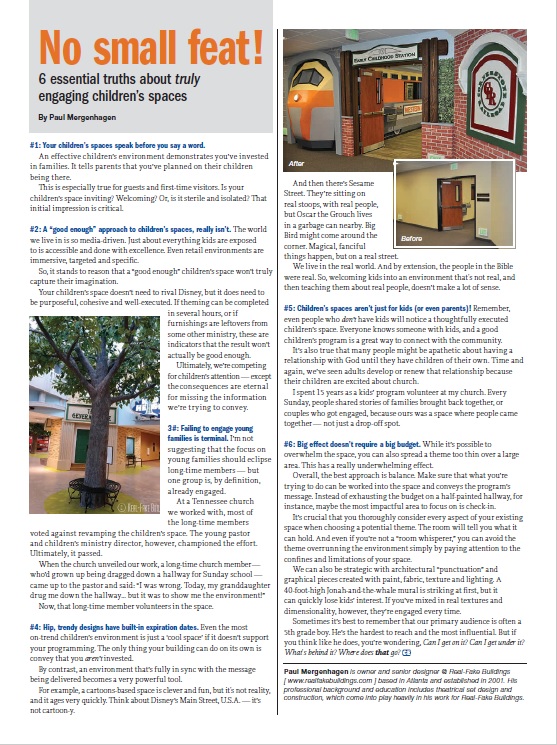
No small feat!
By Paul Mergenhagen
#1: Your children’s spaces speak before you say a word. An effective children’s environment demonstrates that you’ve invested in families. It tells parents that you’ve planned on their children being there.
This is especially true for guests and first-time visitors. Is your children’s space inviting? Welcoming? Or is it sterile and isolated? That initial impression is critical.
 #2: A “good enough” approach to children’s spaces really isn’t. The world we live in is so media-driven. Just about everything kids are exposed to is accessible and done with excellence. Even retail environments are immersive, targeted and specific.
#2: A “good enough” approach to children’s spaces really isn’t. The world we live in is so media-driven. Just about everything kids are exposed to is accessible and done with excellence. Even retail environments are immersive, targeted and specific.
So, it stands to reason that a “good enough” children’s space won’t truly capture their imagination.
Your children’s space doesn’t need to rival Disney, but it does need to be purposeful, cohesive and well-executed. If theming can be completed in several hours, or if furnishings are leftovers from some other ministry, these are indicators that the result won’t actually be good enough.
Ultimately, we’re competing for children’s attention — except the consequences are eternal for missing the information we’re trying to convey.
#3: Failing to engage young families is terminal. I’m not suggesting that the focus on young families should eclipse long-time members — but one group is, by definition, already engaged.
At a Tennessee church we worked with, most of the long-time members voted against revamping the children’s space. The young pastor and children’s ministry director, however, championed the effort. Ultimately, it passed.
When the church unveiled our work, a long-time church member — who’d grown up being dragged down a hallway for Sunday school — came up to the pastor and said: “I was wrong. Today, my granddaughter drug me down the hallway… but it was to show me the environment!”
Now, that long-time member volunteers in the space.

#4: Hip, trendy designs have built-in expiration dates. Even the most on-trend children’s environment is just a ‘cool space’ if it doesn’t support your programming. The only thing your building can do on its own is convey that you aren’t invested.
By contrast, an environment that’s fully in sync with the message being delivered becomes a very powerful tool.
For example, a cartoons-based space is clever and fun, but it’s not reality, and it ages very quickly. Think about Disney’s Main Street, U.S.A. — it’s not cartoon-y.
And then there’s Sesame Street. They’re sitting on real stoops, with real people, but Oscar the Grouch lives in a garbage can nearby. Big Bird might come around the corner. Magical, fanciful things happen, but on a real street.
We live in the real world. And by extension, the people in the Bible were real. So, welcoming kids into an environment that’s not real, and then teaching them about real people, doesn’t make a lot of sense.
#5: Children’s spaces aren’t just for kids (or even parents). Remember, even people who don’t have kids will notice a thoughtfully executed children’s space. Everyone knows someone with kids, and a good children’s program is a great way to connect with the community.
It’s also true that many people might be apathetic about having a relationship with God until they have children of their own. Time and again, we’ve seen adults develop or renew that relationship because their children are excited about church.
I spent 15 years as a kids’ program volunteer at my church. Every Sunday, people shared stories of families brought back together, or couples who got engaged, because ours was a space where people came together — not just a drop-off spot.
#6: Big effect doesn’t require a big budget. While it’s possible to overwhelm the space, you can also spread a theme too thin over a large area. This has a really underwhelming effect.
Overall, the best approach is balance. Make sure that what you’re trying to do can be worked into the space and conveys the program’s message. Instead of exhausting the budget on a half-painted hallway, for instance, maybe the most impactful area to focus on is check-in.
It’s crucial that you thoroughly consider every aspect of your existing space when choosing a potential theme. The room will tell you what it can hold. And even if you’re not a “room whisperer,” you can avoid the theme overrunning the environment simply by paying attention to the confines and limitations of your space.
We can also be strategic with architectural “punctuation” and graphical pieces created with paint, fabric, texture and lighting. A 40-foot-high Jonah-and-the-whale mural is striking at first, but it can quickly lose kids’ interest. If you’ve mixed in real textures and dimensionality, however, they’re engaged every time.
Sometimes it’s best to remember that our primary audience is often a 5th grade boy. He’s the hardest to reach and the most influential. But if you think like he does, you’re wondering, Can I get on it? Can I get under it? What’s behind it? Where does that go?
Paul Mergenhagen is owner and senior designer at Real-Fake Buildings based in Atlanta and established in 2001. His professional background and education includes theatrical set design and construction, which come into play heavily in his work for Real-Fake Buildings.


